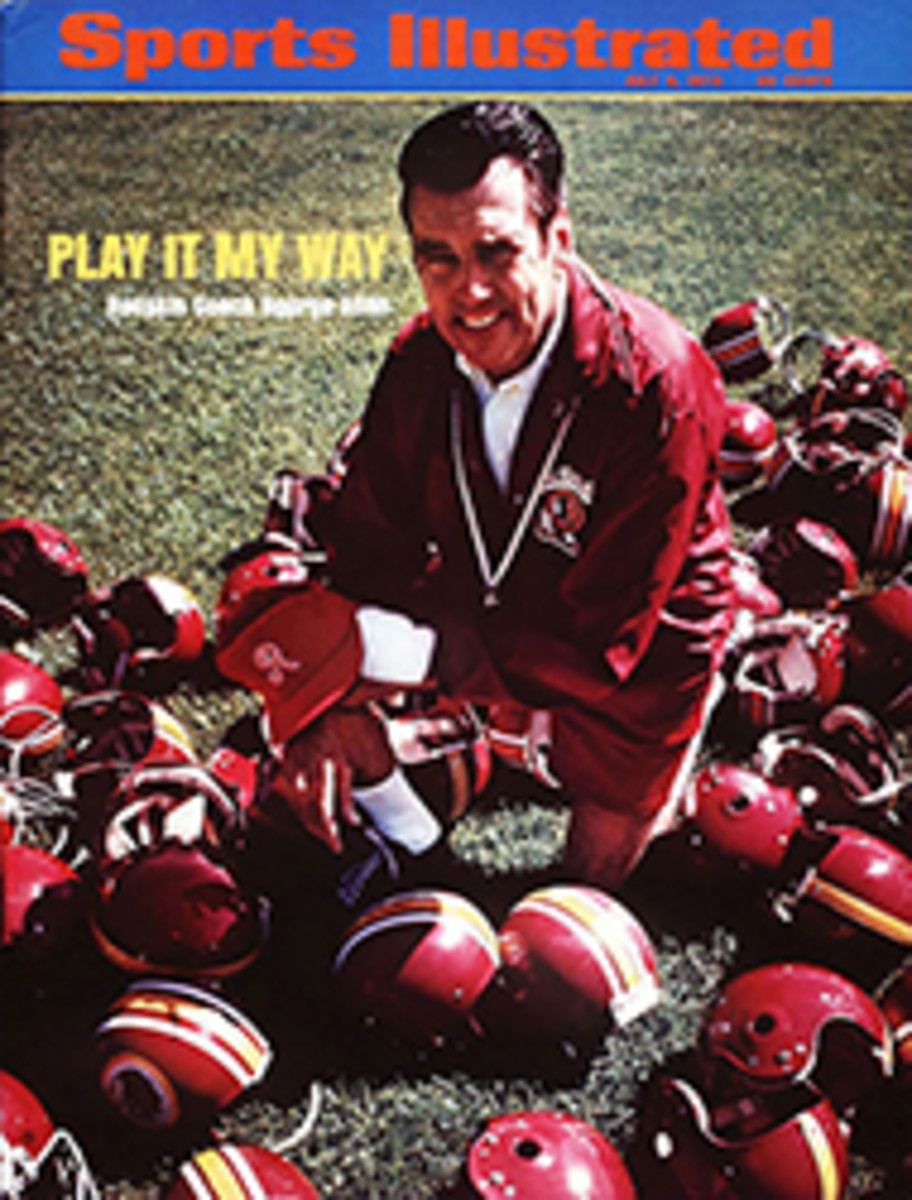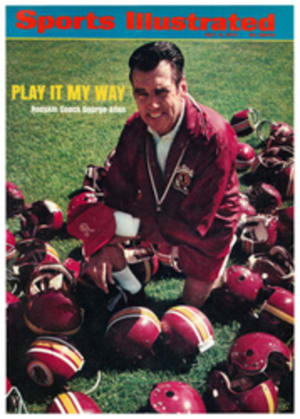
They have wins in their sails
There is not much to attract even antelopes to Antelope Valley, a dull, reddish-gray stretch of desert on the edge of the Mojave some 70 freeway miles north of Los Angeles. Its major enticements are Palmdale, which has a reservoir, Lancaster, which is the home of Antelope Valley Junior College, and some pretty good rabbit hunting. Then, quite by accident, a couple of visitors built more like bull elephants than the fleet creatures that gave the valley its name discovered the wind, and Antelope Valley became hallowed ground. The visitors were discus throwers, and to anyone whose cup of tea is sending saucers flying, a reliable wind is a precious commodity.
Miles Lister and Dave Weber were the pioneers. Discus throwers living and working in Los Angeles, they had driven out from the city one chilly dawn in 1968 to shoot rabbits. They parked Weber"s Volkswagen in a likely spot and Lister opened the door to climb out. Well. no, that isn't quite the way it worked. Lister, who is 6'5" and 265, tried to climb out only to find himself penned in by the force of a 50-mph gale.
"Wow!" he shouted when he finally shouldered his way out of the car and clung to its side to keep from being blown off into the desert. "What a great find!"
Only Hollywood special effects men and discus throwers could say that. A wind that bends palm trees nearly double, hurls sand and debris through the streets of Palmdale and Lancaster like grapeshot and regularly obliges the residents to walk backward is virtuous only because of regulations in track and field that mainly concern the discus throw. In most other events—sprinting, the jumps, the hurdles—no official record can be claimed if a wind greater than 4.4 mph is at the performer's back. In races of one lap or more the runners get the breeze coming and going. But in the discus any wind is allowed.
There is no doubt that a strong one can help a throw, but the degree cannot be measured. To obtain meaningful data anemometers would have to be spotted from ground level up to 30 feet in the air, like barrage balloons. And which wind direction provides significant aid? Among discus men the consensus is that the wind helps most when it is steady and quartering, and that 40 mph can add at least 20 feet to a well-executed throw.
The kinesthetic delight of hurling a discus 10% farther than heretofore, plus the esthetic gratification of watching a smoothly tapered, two-kilo wooden platter soar so far and so gracefully, are only two of the reasons why discus throwers are so turned on by the wind. There are also practical factors. No recent world discus record has been set without the aid of a good, brisk wind. The wind can also help run-of-the-ring performers achieve the qualifying standards they need to compete in national championships or in the Olympic Games, or possibly just to surpass 200 feet, the event's four-minute mile. Even for the very best, such an ego trip can be an essential morale booster. This is because throwing the discus is an act that often tumbles the athletes who try it into a state of acute depression.
"Discus throwers are a breed apart." says Gary Ordway, a high school teacher from Huntington Beach, Calif. who ranked ninth in the U.S. last year although he is only 5'10". "Our event is such a problem in timing, involving so many complex motor skills, that we are prone to high cycles and low cycles. We get frustrated, moody and withdrawn."
"The technique is like the golf swing," says John Powell, a San Jose policeman who finished fourth in the discus at the 1972 Olympics. "It involves precise moves carefully linked together. If one or two go wrong the whole thing goes haywire."
Who can blame discus throwers, then, for seeking out such meccas of the wind as Reno, Nev., where Jay Silvester set the current world record of 224'5" back in 1968; or Malm√∂. Sweden, where the monstrous Swede. Ricky Bruch, used the wind blowing off the √ñresund Straits to equal Silvester; or Long Beach, Calif., where the 1972 Olympic champion, Lud-vik Danek of Czechoslovakia, has posted three of his best marks—or Antelope Valley?
Silvester is a special case. Usually a calm athlete, he got carried away one Sunday afternoon in May 1968 when a sudden wind slammed a storm door shut at the back of his house in Smithfield, Utah and shattered its windows. Ignoring the scattered pieces of glass, Silvester snatched up his discus, rushed out to the high school track three miles away and launched an ego builder of 242'5", a prodigious 29 feet over the then existing world record. "The wind must have been between 40 and 50 mph," he recalls, "and there was a slight snowfall. It was a glorious day."
Had they brought their own discuses with them the day they discovered Antelope Valley, Lister says, he and Weber would have been out on the freeway, boots and all, pirouetting and flinging like crazy. Instead, they filed their find away for future reference—and action.
Action came after student demonstrations in 1970 caused the cancellation of the West Coast Relays at Fresno State. Determined to throw, Lister headed for the Valley.
Conditions were perfect: a quartering wind of about 40 mph, a stadium open to the wind on three sides. Elated, Lister went to work and soon was watching his tosses slide down the wind farther than they had ever gone before. The field was unlined, but Lister paced off his longest throw and conservatively estimated it at 212 feet, 15 feet beyond his previous best. All that was needed now were some officially authorized discus-only meets. Records would surely follow.
The next weekend Lister helped organize a competition for himself and six others, but alas, the wind failed to cooperate. "Can't understand it," muttered Antelope Valley's track coach, Austin Jordan. "First time in five months we haven't had gale winds around here."
They had them when Lister and his friends next showed up. That was in February 1971, and in the group was Jim Howard, from Arcadia High in Scotts-dale, Ariz. First, using the regulation discus (4 pounds, 6.4 ounces), Howard threw 173'6", close to the 175'8" record set by a schoolboy in 1937. Next, using the lighter intcrscholastic discus (3 pounds, 9 ounces), Howard exceeded the high school record by four inches with a heave of 201'7".
It was a good start, but the discus jackpot was not hit until 10 weeks later, on Sunday, May 16. This was the day after the Bakersfield (Calif.) Classic, a conventional, full-event evening track and field meet. The preliminary reports indicated superb wind conditions in the desert, so Lister had no difficulty persuading a field of 10 top throwers to come to Antelope Valley for a discus-and-shotput-only meet the following afternoon.
Few of the throwers competing in the discus at Bakersfield could claim to be on a high cycle (the event was won by Silvester with a throw of just over 203 feet), but at least one, Ed Kohler, was so pleased with his form that he drove out that night to Lancaster and slept in his car, waiting for the start. The others, only slightly more restrained, arrived the following morning. One car, bearing Tim Vollmer, a world-class thrower then stationed at Fort MacArthur, almost never reached the field. Vollmer spotted a garbage pail being blown down the middle of the highway and demanded that the driver stop right there for a few throws.
The caravan, fortunately, forged on through the gale to the Antelope Valley campus, where the scene would have struck anybody but a discus thrower as odd. Out in the desert clouds of sand swirled across the horizon. Large men in sweat suits were leaping up and down and cheering as winds of 40 to 45 mph whipped across the football field. Even the first stand-up throws were remarkable, soaring out well over 180 feet.
When the meet got under way Jay Silvester had a foul throw of 239'11" and then sent a legal toss far downfield and out onto the rubberized asphalt running track. It left a scar on the track 230'11" from the ring, six feet beyond his world record. Vollmer threw 221'1", his best ever by a margin of almost 15 feet. Mike Hoffman, formerly of Brigham Young, reached 216 feet, an improvement of over 23 feet. Seven of the 10 discus throwers topped 205 feet. Never before had the discus been thrown so far by so many in a single meet. Said one, fearing legislation against wind-aided throws, "we may have gone too far this time."
As luck would have it, they did not go far enough. Monday morning when Jordan arrived at his office he discovered that the application for the AAU sanction had not been mailed; it was still lying on the top of his desk. So Silvester's world mark would never be recognized.
A scattering of discus meets have been held at Antelope Valley since with excellent results, though nothing to match the super throws that took place that memorable Sunday. The established routine now is to make a preliminary weather check on Thursday, then check again early Sunday morning, if the wind is up, the discus throwers come blowing in from all directions. Lister is optimistic that a record-breaking burst could happen any week now. "A day like that Sunday will happen again," he predicts, "because Mother Nature is going to will it."

